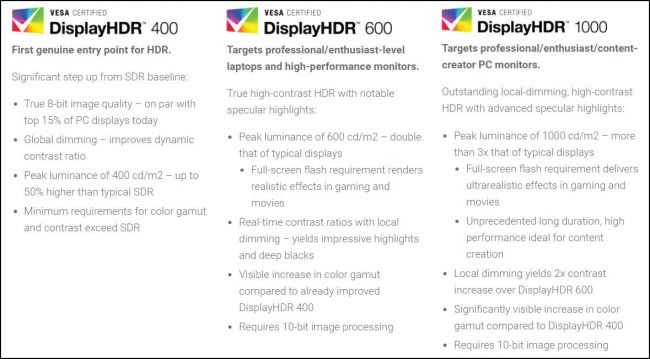Narrowing the choice of displays has always been a difficult process, with customers having to factor in resolution, refresh rate, size for its relative pixel-per-inch and many other nitty gritty details that lead to the optimal experience. To lighten the load, VESA has attempted to give a clearer definition of the latest tech, High Dynamic Range (HDR), by creating a standard it calls DisplayHDR.
For a while, HDR was simply a blanket term provided for new technology to entice customers into making a purchase without the company disclosing where on the spectrum its version of HDR fell. Of course, all HDR is above the standard, but it becomes difficult to tell value for money without companies disclosing their method of testing and where its quality falls.
“HDR logos and brands abound, but until now, there has been no open standard with a fully transparent testing methodology. Since HDR performance details are typically not provided, consumers are unable to obtain meaningful performance information. With DisplayHDR, VESA aims to alleviate this problem,” Vesa explains.
VESA collaborated with other industry professionals from over two dozen established companies from many different fields, including displays, graphics cards, CPUs and many more. It’s initial 1.0 version of DisplayHDR only factors in the standard LCD panels, before planning to expand to the newer OLED technology when it gains traction.
DisplayHDR 1.0 is comprised of three unique categories, spanning DisplayHDR 400 as its lower end baseline to its midrange DisplayHDR 600 and high-end DisplayHDR 1000. These are built using a pre-established set of parameters that distinguish the quality for each display and take the complicated research out of the consumer’s hands.
Among other factors, luminance rating seems to be one of the most important and perhaps the namesake for each certification. The baseline requires 400 nits, the midrange 600 and, of course, the high-end sits with a requirement of 1000 nits.
“First, 400 nits is 50 percent brighter than typical SDR laptop displays,” VESA’s chairman Roland Wooster explains the reasoning behind the importance of luminance in DisplayHDR 1.0. “Second, the bit depth requirement is true 8-bit, whereas the vast majority of SDR panels are only 6-bit with dithering to simulate 8-bit video. Finally, the DisplayHDR 400 spec requires HDR10 support and global dimming at a minimum.
“With this tiered specification, ranging from baseline to high-end HDR performance levels, PC makers will finally have consistent, measurable HDR performance parameters. Also, when buying a new PC, consumers will be able to view an HDR rating number that is meaningful and will reflect actual performance.”
KitGuru Says: Of course, the purchase of a monitor is a lot more complicated than HDR quality alone, but VESA does help clarify things a bit for customers. Do you like VESA’s new DisplayHDR classification system?
 KitGuru KitGuru.net – Tech News | Hardware News | Hardware Reviews | IOS | Mobile | Gaming | Graphics Cards
KitGuru KitGuru.net – Tech News | Hardware News | Hardware Reviews | IOS | Mobile | Gaming | Graphics Cards



